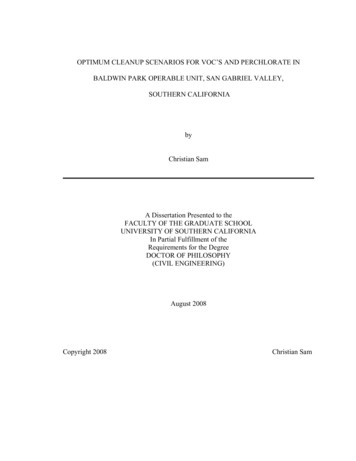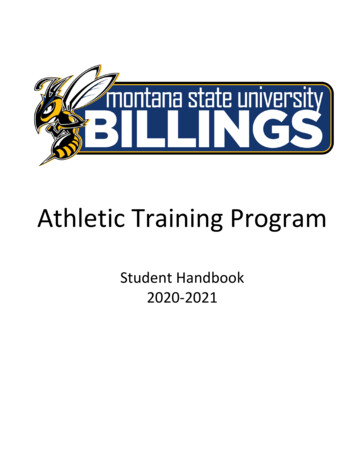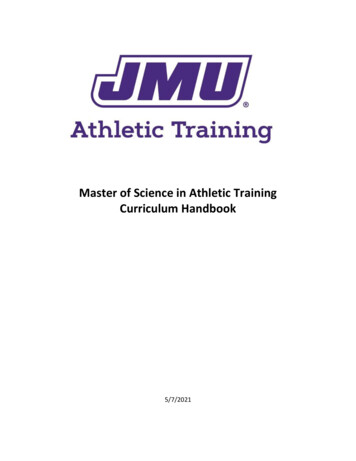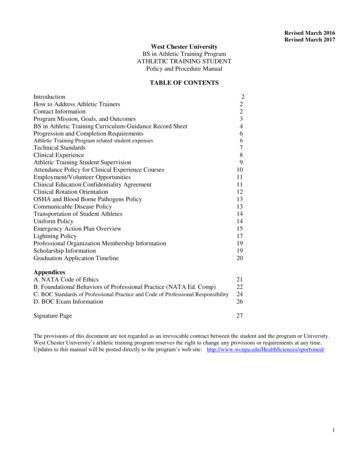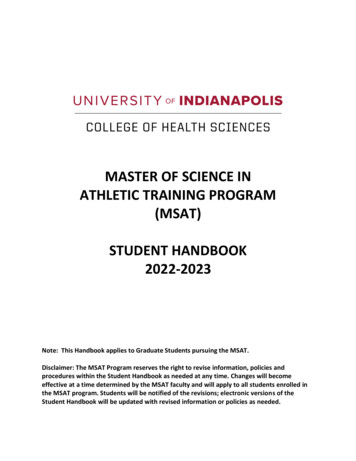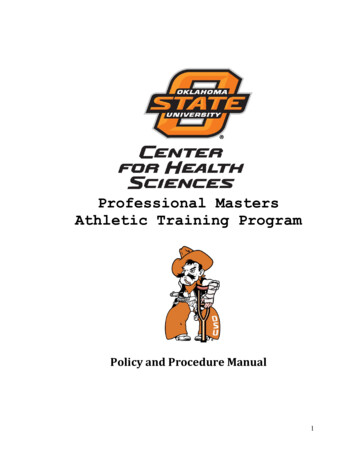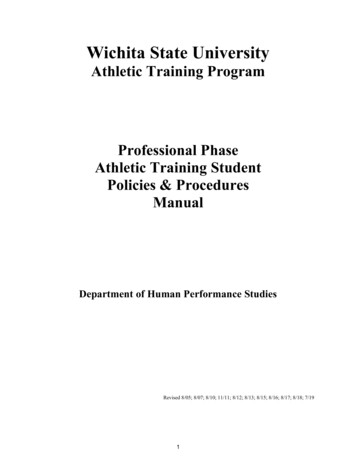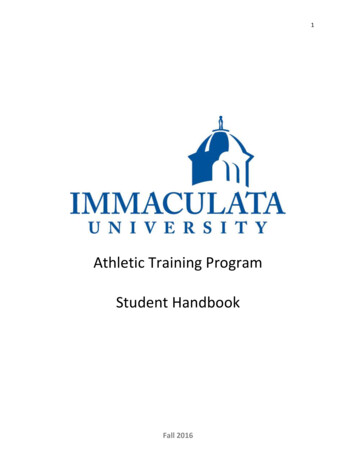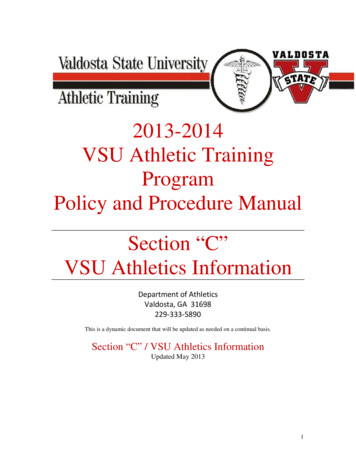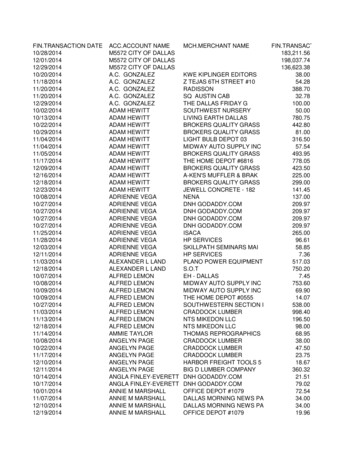
Transcription
Baldwin Wallace UniversityAthletic TrainingProgramPrepared by: The Athletic Training Program Faculty – Revised August 2019
Baldwin Wallace University Athletic Training Program Student HandbookTABLE OF CONTENTSPage1Introductiona. Historical Background1b. Athletic Training – The Professionc.1-2Specifically @ Baldwin Wallace University2Academic Program3a. Mission3b. Program Objectives/Goals3c.Admission Requirements3-5Additional Required Costs5Non-Discriminatory Policy5Technical Standards5-6Students with Disabilities6Academic Plan / Curricular Content /Graduation RequirementsTransfer Policy / Student Retention Policy / COAST / Iota Tau AlphaAthletic Training Major – 8 semester schedule77-89Athletic Training Facility Management10Clinical Expectations and Requirements10Days Off Policy / Attendance10-11Communicating with your Preceptor11Sports Participation and Athletic Training11Off-campus Employment and Athletic Training11Team Travel11-12First Aid /Conduct with Athletes / Dating Athletes12Dress Code12-14Communication14Confidentiality of Records14OSHA14-15Sexual Misconduct Reporting15Miscellaneous15Standards of Ethical Conduct16-17Disciplinary / Incident Procedures17-18Forms19-26a. Incident Form19b. Application20c.21Technical Standardsd. Immunization Record22e. Communicable Disease Policy Verification23f.24Confidentiality Statementg. Sun setting CAATE Program Agreement25-26ii8/2018
IntroductionHistorical BackgroundThe National Athletic Trainers’ Association was founded in 1950 when a core group of approximately 200athletic trainers met in Kansas City to discuss the future. Since that time the NATA has grown dramatically andcurrently the membership exceeds 40,000 worldwide allied health care professionals. The NATA isgeographically divided into ten districts. Ohio is a member of the largest district, District Four, known as theGreat Lakes Athletic Trainers Association (GLATA). Ohio also has a state governed organization known as theOhio Athletic Trainers’ Association (OATA). Each district and state organization is run independently butcollectively forms the NATA. Currently headquartered in Texas, the NATA is chaired by a full-time executivedirector and staff. Members serve on the state, district and national level as volunteer leaders for theassociation and facilitate all of the NATA’s 20 committees. The stated mission of the NATA is to enhance thequality of health care provided by certified athletic trainers and to advance the profession of athletic training.Athletic Training: The ProfessionThe certified athletic trainer is a highly educated and skilled professional specializing in health care of thephysically active. In 1990, the American Medical Association (AMA) officially recognized athletic training as anallied health profession. Such recognition helped enhance respect for the athletic training profession andincreased accountability to professional and educational expectations.In an effort to standardize educational preparation, the Joint Review Committee on Athletic Training wascreated (JRC-AT). The JRC-AT was charged with the responsibility of evaluating Athletic Training Programsseeking accreditation and giving recommendations to the Commission on Accreditation of Allied HealthEducation Programs (CAAHEP). In 2003, the JRC-AT leadership decided that athletic training education hadoutgrown the constraints of CAAHEP and began the process of becoming an independent accrediting agency.Effective July 2006, the JRC-AT officially changed its’ name to the Committee for Accreditation of AthleticTraining Education (CAATE) and is the accrediting agency for all Athletic Training Programs. The AmericanAcademy of Family Physicians (AAFP), the American Academy of Pediatrics (AAP), the American OrthopedicSociety for Sports Medicine (AOSSM) and the National Athletic Trainers' Association (NATA) cooperate tosponsor CAATE and collaborate to develop the Standards for Entry-Level Athletic Training EducationalPrograms. In 2014, the Council for Higher Education Accreditation (CHEA) granted CAATE recognition as anacademic accrediting agency.The Athletic Training Program accreditation process has provided greater credibility to the qualifications ofathletic trainers and has created new employment opportunities. Certified athletic trainers are now employed ina variety of settings and roles including, but not limited to: secondary schools, colleges, universities,professional sports, sports medicine clinics, corporate/industrial settings, the military, physician extenders,medical supply/equipment sales, college educators, researchers, and administrators.Athletic trainers certified post 2003 have, at minimum, a bachelor’s degree in athletic training from anaccredited curriculum program. (Effective January 1, 2004, in order to be eligible for the certification exam, anindividual must have graduated from an accredited athletic training program.) In May 2015, the AT StrategicAlliance Committee determined athletic training wouldAthletic Training: The Profession (con’t)begin a degree change transition. All CAATE Athletic Training Programs will require professional programs beat the master’s degree level. The degree transition time line may vary from institution to institution, however,current CAATE baccalaureate professional athletic training programs may not admit, enroll, or matriculatestudents into the athletic training program after the start of the fall term 2022. Students entering BW in the Fallof 2018 will be the last undergraduate class eligible for selection into BW’s CAATE accredited AT Program.The athletic training education curriculum focuses on specific content within the following competencies:Evidence-based Practice, Prevention & Health Promotion, Clinical Examination & Diagnosis, Acute Care of18/2018
Injury & Illness, Therapeutic Interventions, Psychosocial Strategies & Referral, Healthcare Administration, andProfessional Development & Responsibility.The 5th Edition of Athletic Training Education Clinical Competencies provides a listing of specific requiredcompetencies within the content areas listed above. Please refer to the intranet Blackboard web site for areference guide delineating where each competency is instructed within the Athletic Training Program atBaldwin Wallace University. Certified athletic trainers must fulfill the requirements for certification establishedby the Board of Certification, Inc. (BOC) and pass a national examination. The former BOC certification examconsisting of a written portion with multiple-choice answers, a practical section, and a written simulationcomponent was administered in this format for the last time in April 2007. Currently, the BOC examination isadministered in a computer-based format. The test covers a variety of topics within the five practice domains ofathletic training:1. Injury and Illness Prevention and Wellness Promotion2. Examination, Assessment and Diagnosis3. Immediate and Emergency Care4. Therapeutic Intervention5. Healthcare Administration and Professional ResponsibilityOnce an athletic training student passes the certification examination, proving skills and knowledge within eachof the five domains, the designation of “ATC” credential is permissible. In order to maintain the ATC status, aset number of continuing education units (CEUs) must be completed every 2 years. In Ohio, like many otherstates, BOC certification is required for state licensure. Individuals in the state of Ohio must be licensed inorder to refer to themselves as an athletic trainer. The correct means to identify licensure in the state of Ohio isto use licensed the letters “AT”, licensed athletic trainers should sign their name as Jane Smith, AT.Specifically at Baldwin Wallace UniversityBaldwin Wallace University’s Athletic Training Program evolved from a well-established internship program toan accredited curriculum. In April 2003, the program earned initial accreditation by the Commission onAccreditation of Allied Health Education Programs (CAAHEP) as recommended by theJRC-AT. Effective2006, due to the JRC-AT’s decision to become an independent accrediting agency, Baldwin WallaceUniversity’s Athletic Training Program was recognized as being accredited by the Commission forAccreditation of Athletic Training Education (CAATE). CAATE is the new name for the former accrediting bodypreviously referred to as the JRC-AT. Post a successful 2017 site visit, BW’s Athletic Training Programreceived “Continuing Accreditation” from CAATE with our next comprehensive review scheduled for 20262027. However, it has been decided that Fall 2018 will be the last class admitted into the undergraduateCAATE Athletic Training Progam at Baldwin Wallace.Our Athletic Training Program is divided into two portions: the Level I/First Year students and the acceptedclinical program students/Level II-IV.The curriculum content specifically covers the 8 educationalcompetencies as listed in the previous section. Each content area has expected outcomes for acquisition ofknowledge and skills as well as the mastery of comprehensive clinical patient care, referred to as ClinicalIntegration Proficiencies (CIP)s.Mastery of skills is demonstrated via the successful completion of the clinical modules. The modules are basedon the criteria dictated by the latest edition of the NATA Education Council’s competencies. Students mustmeet specific requirements and apply for admission into the clinical portion of the Athletic Training Program.The Level I/First Year phase requires a consecutive one-year observation period. During this initial year,students are expected to gain practical experience in observing the athletic training clinical atmosphere atBaldwin Wallace University as well as an understanding of the duties/responsibilities of an athletic trainer. Thislevel is open to any student enrolled in Baldwin Wallace University interested in majoring in Athletic Training.Detailed information regarding the admission process will follow in the proceeding pages.28/2018
Academic ProgramMission StatementThe mission of the Baldwin Wallace University Athletic Training Program builds upon that of the University,anchoring itself on the foundation of liberal arts studies. Our accredited comprehensive curriculum preparesstudents to become BOC certified athletic trainers and challenges them to achieve life-long personal andprofessional goals. We believe in providing academic and clinical diversity as demonstrated by our vast arrayof experiential learning opportunities. The Athletic Training Program strives to foster intellectual curiosity andutilize knowledge, skills, attitudes, and values as catalysts in cultivating the student into a highly effectiveprofessional and a contributing, compassionate citizen.Program Objectives/GoalsThe Objectives/Goals of our program are:1. to successfully prepare students to become BOC certified athletic trainers2. to offer a challenging and comprehensive curriculum3. to prepare students for a variety of employment settings4. to provide opportunities for leadership and exposure to professional conferencesStudent Learning OutcomesStudents in our program will:1. Interpret and integrate didactic knowledge and demonstrate practical skills in clinical decision making2. Demonstrate ability to collaborate with the patient and other healthcare professionals in patient caredecision-making3. Apply skills of athletic training management, organization and administrationAdmission RequirementsStudents seeking admission to the athletic training program must meet the requirements outlined below. FirstYear/Level I students may be omitted from the list of potential athletic training students (ATS) if all therequirements have not been met. Furthermore, fulfilling all requirements does not guarantee acceptance intothe Athletic Training Program. Determining factors include: the success of Level I/First Year experience,meeting all academic prerequisites, completion of Level I/First Year Clinical Modules, professionalism, and thenumber of students already enrolled in the Athletic Training Program. The number of students admitted intothe program varies from year-to-year. Application packets must be submitted by the end of the springsemester following the completion of the below requirements. Points are allotted for each section of thepacket. A score of 120 out of the possible 142 is required for admittance. Incomplete portions will result in adeduction of possible points. Any of the forms identified below as part of the application process can be foundin the appendices or on the COAST Organization Blackboard site under Course Documents.1. Must be a Declared Athletic Training Major and complete the Athletic Training Program Application: seeappendices for copy of form (8 pts)2. Documentation of Observation Requirements: Minimum of 75 hours required during the course of thefirst year (35 hours must be completed as part of the HPE 182 course). Students will select a variety ofathletic training clinical sites and events in which to complete the observation requirements. Hours areto be documented on a clinical hours log supplied by the program. The logs are to be signed bi-weekly38/2018
by an AT that can verify your attendance. Students may accumulate no more than 25 hours off-campusand cannot begin accruing observation hours until after the first day of classes. Off-campus observationhours must be documented by a BOC certified and state licensed athletic trainer. A form for off-campusobservation hours is available on the blackboard site. All documented hours must be submitted to theProgram Director at the conclusion of the spring semester. (15 pts; partial points will not be awarded forobservation hours totaling less than 75 hours)3. Prerequisite Classes (points are calculated by taking the earned letter grade’s point value andmultiplying it by 3 for the HPE/BIO prefix courses and by 2 for the PSY prefix course.(Example: A in HPE 202 4.0 pts x 3 12 pts; maximum number of points possible is 68 pts) HPE 202 Principles of Athletic Training HPE 205 First Aid and Safety BIO 203L Human Anatomy and Physiology I BIO 204L Human Anatomy and Physiology II or HPE 206 Medical Terminology PSY 100 Principles of Psychology Science HPE 182 Introductory Practicum to Athletic Training(Letter Grade Values: A 4.0, A 4.0, A- 3.667, B 3.333, B 3.0, B- 2.667,C 2.333, C 2.0, C- 1.667, D 1.333, D 1.0, D- .667)4.“Overall” Grade Point Average (GPA): a minimum cumulative GPA of 2.5 for ALL attemptedcoursework is required. Applicants must earn a minimum grade of a “C” in BIO 203 and 204 and aminimum of a “B” in HPE 202, HPE 205 and HPE 182 to be eligible for selection(points are calculated by multiplying overall GPA by 5: ex. GPA of 2.7 x 5 13.5 pts; max. number ofpoints is 20)5. The student must have current Adult CPR with AED for the HealthCare Provider (BLS) and a First Aidcard from American Heart Association or equivalent certifications matching the ECC standards.Students will have the opportunity to earn this certification while taking HPE 205. (1 pt)6. Proficiency Examination: date and time for this exam will be announced during the spring semester. (8maximum points possible [the points allotted per question will vary depending on number of testquestions] ex: if 80 test questions each question is worth 0.1 pt: 65 correct answers 6.5 pts)7. Submission of Three Electronic Recommendations to be completed by a coach, AT, employer, HSinstructor, guidance counselor, or college professor. It is the responsibility of the student to send anelectronic link to the individual completing the reference. Recommendations from BW’s athletic trainingstaff are not permitted. (5 pts per recommendation – 15 pts)8. Submission of a Level One/First Year Student Evaluation Form completed by one of BW’s ATs (5 pt)9. Student must complete OSHA Blood-Borne Pathogen training- a training provided via HPE 205 (1 pt)10. The Technical Standard Form must be signed and submitted to the Program Director verifyingunderstanding of physical, emotional and mental requirements of the program (1 pt)Students that score below 120 points may be further evaluated on the below criteria in order to provide anadditional opportunity to obtain the minimum 120 required points: Participation in COAST / First Year meetings/events ( 2 meetings attended 1 pts, 3 meetingsattended 2 pts, 4 or more meetings attended 4 pts) Quality in which modules were completed (3 or less marginal scores 5 pts, no more than 7marginal scores 3 points, no more than 9 marginal scores 1 point) NATA Student Membership (1 pt) Final score from the Level One/First Year Athletic Training Student Evaluation Form completed by aBW Staff Preceptor (Performance as well as most 4 pts; better than most 5 pts, equaled by few48/2018
6 pts, better than almost all (top 2%) 7 pts . no points awarded for min. or unsatisfactoryperformance ratings)Depending on number of applicants or special circumstances, interviews with two or more of the AthleticTraining Program Faculty and Staff may be required for final admittance into the Athletic Training Program.All applicants are notified in writing of their status of admission prior to the start of the new school year. If theapplication to the clinical phase is rejected, the student has the opportunity to appeal the decision. The appealmust be made within two weeks after official notification and should be directed to the Associate Dean of theSchool of Health, Physical Education & Sport Sciences with a copy forwarded to the Program Director. Thestudent must submit all materials that may substantiate the appeal. The student will then appear before anappeals committee (consisting of the Program Director, one member of the Athletic Training Program faculty,one member of the HPESS faculty, and chaired by the HPESS Associate Dean.) A majority decision of thecommittee is necessary for the final decision. The student will be notified, in writing, within one week of thecommittee's decision. If the student’s appeal is granted by the committee, the student will be permitted to reapply the following year.Immediate Requirements Once Admitted Students must have complete immunization records on filespecific focus on the appropriate immunizations for measles (Rubeola), mumps, German measles (Rubella), chicken pox(Varicella), Tdap booster within the last 10 years & flu vaccine Proof of Hepatitis B vaccination (If needed, vaccination series may be obtained at the BW HealthCenter)Must sign Communicable Disease Policy & HIPPA Confidentiality FormAthletic Training Program Additional Required CostsThe majority of costs for supplies associated with participation in the Athletic Training Program are coveredthrough student tuition; however, some additional fees do exist. Those extra costs are estimated to be lessthan 1,000 and include: BCI & CI Criminal Background testing ( 66 - 132); TB testing ( 10- 20);OATA/GLATA/NATA student membership fees ( 340), First Aid/ ECC certification related fees ( 30), personalhealth insurance (varies), BOC exam registration fee ( 335), and costs associated with off-campustransportation to clinical affiliated sites (which vary in distance, but do not exceed 20 miles one way). Studentsare also encouraged to attend conferences which would require personal funds supplemented by the COASTstudent organizational budget. While every attempt is made to anticipate additional costs, the above list is anestimate of costs and is not exhaustive or exclusive.Non-Discriminatory Policy (Excerpt from the University Catalog)Baldwin Wallace University does not discriminate because of race, creed, age, disabilities, national origin,gender or sexual orientation in the administration of its policies or programs.Technical Standards for the Baldwin Wallace University Athletic Training ProgramThe Athletic Training Program at Baldwin Wallace University is a rigorous and intense program that placesspecific requirements and demands on the students enrolled in the program. An objective of this program is toprepare graduates to enter a variety of employment settings and to render care to a wide spectrum ofindividuals engaged in physical activity. The technical standards set forth by the Athletic Training Programestablish the essential qualities considered necessary for students admitted to this program to achieve theknowledge, skills, and competencies of an entry-level athletic trainer, as well as meet the expectations of theprogram's accrediting agency. All students admitted to the Athletic Training Program must have the followingabilities and expectations. In the event a student is unable to fulfill these technical standards, with or withoutreasonable accommodation, the student will not be admitted into the program. Compliance with the program’stechnical standards does not guarantee a student’s eligibility for the BOC certification exam.58/2018
Technical Standards for the Baldwin Wallace University Athletic Training Program (con’t)Candidates for selection to the Athletic Training Program will be required to verify they understand and canmeet certain technical standards with or without accommodation.Candidates for selection to the Athletic Training Program must demonstrate:1. The mental capacity to assimilate, analyze, synthesize, integrate concepts and problem solve toformulate assessments and therapeutic judgments and to be able to distinguish deviations from thenorm.2. Sufficient postural and neuromuscular control, sensory function, and coordination to performappropriate physical examinations using accepted techniques; and accurately, safely and efficiently useequipment and materials during the assessment and treatment of patients.3. The ability to communicate effectively and sensitively with patients and colleagues, including individualsfrom different cultural and social backgrounds; this includes, but is not limited to, the ability to establishrapport with patients and communicate judgments and treatment information effectively. Students mustbe able to understand and speak the English language at a level consistent with competentprofessional practice.4. The ability to record the physical examination results and a treatment plan clearly and accurately.5. The capacity to maintain composure and continue to function well during periods of high stress.6. The perseverance, diligence and commitment to complete the Athletic Training Program as outlinedand sequenced.7. Flexibility and the ability to adjust to changing situations and uncertainty in clinical situations.8. Affective skills and appropriate demeanor and rapport that relate to professional education and qualitypatient care.If a student needs reasonable accommodation in order to meet these technical standards, he/she shouldregister with Disability Services for Students to determine what, if any, reasonable accommodation isappropriate and/or feasible without creating an undue hardship for Baldwin Wallace. Please visit this websitefor information on how to Get Connected with DSS: s/.All students applying for admittance into the Athletic Training Program must submit a signed TechnicalStandards form (see appendices for a copy), certifying that they have read and understand the technicalstandards listed above, and believe to the best of their knowledge that they meet each of the standards with orwithout accommodationFor individuals that require some accommodations, an excerpt from the University’s catalog has been includedin this handbook (see Baldwin Wallace University Policies and Procedures for Students with Disabilities),describing the student disability services available at Baldwin Wallace University. You are responsible forcontacting the Office of Disability for more complete and detailed information.Baldwin Wallace University Policies and Procedures for Students with Disabilities(Excerpt from the University Catalog)Baldwin Wallace University is committed to providing all students equal access to learning opportunities.Students who have, or think they may have a disability (e.g. mental health, attentional, learning, vision,hearing, physical or systemic) and would like to determine if they are eligible for reasonableaccommodations should contact Disability Services for Students at (440) 826-2147 or disability@bw.edu.Additional information about how to get connected with DSS is available at: ages/default.aspx.68/2018
Academic PlanFor information regarding course sequencing please refer the HPESS website, specifically the Athletic TrainingEight Semester Schedule. An additional resource when planning to progress through the curriculum is theAcademic Program Evaluation available via WebExpress. In order to properly utilize the Academic ProgramEvaluation, it is imperative that the Registrar’s office has record of the student’s declared major(s) and minors.Advisors and students utilize the Academic Program Evaluation in each advising session.Curricular ContentAthletic Training Program courses are designed to fulfill the Athletic Training Course Competencies asdeveloped by CAATE. These are identified on the Blackboard site. The curriculum is designed to be a total of8 semesters with 6 semesters of clinical experience under the direct supervision of a preceptor. The Preceptorcollaborates with the ATS to complete designated modules that demonstrate proficiency in various athletictraining skills. A preceptor must directly supervise students during the delivery of athletic training services. Thepreceptor must be physically present and have the ability to intervene on behalf of the athletic training studentand the patient. Students are exposed to upper and lower extremity predominate sports, equipment intensivesports, and general medicine. The curriculum phase requires dedication and commitment to the AthleticTraining Program. Due to the large amount of time demanded of athletic training students it is imperative thatstudents possess good time management skills. With each new clinical rotation, the athletic training student isexpected to attend practices, scheduled treatments, and competitions as well as maintain good academicperformance in the didactic setting.Graduation RequirementsIt is the responsibility of the student to meet all requirements for graduation. The general curriculumrequirements for graduation are located in Section I of the University Catalog. The University Catalog isavailable on-line and to ensure accurate information students should refer to the edition that corresponds withtheir year of entry into the University. In addition, the clinical requirements from the Athletic Training Programmust be completed, including off- campus rotations at approved clinical sites.Transfer PolicyStudents interested in transferring into the Athletic Training Program at Baldwin Wallace University from othercolleges/universities must follow all procedures for admission to the University as outlined in the Universitycatalog. Successful candidates for admission typically submit credentials from colleges/universities accreditedby one of the nation’s six regional accrediting associations, have met the general admission requirements forfirst time students, and have earned a B average in their college/university course work. Candidates should bein good academic, social, and financial standing at their previous institutions. Students not in good standing ata previous institution may be considered for admission provided they have been out of school at least one fullyear prior to their proposed date of entrance. Transfer students must complete all of the First year/LevelOne outlined admission criteria requirements in order to be eligible for selection into the AthleticTraining Program. Because of the accreditation requirements, the Baldwin Wallace University AthleticTraining Program must guarantee that the student has learned and completed each of the establishededucational competencies upon completion of the major. Therefore, the following Athletic Training Educationcoursework must be completed at BW unless otherwise determined by the Program Director: HPE 181, 202,205, 208, 281, 282, 305, 306, 307, 308, 309, 310, 381, 382, 481X, 482 and BIO 203, 204. Please note thatdue to course sequencing, required clinical rotation hours, and the First Year/ Level One required selectionprocess, transfer students should expect to be actively enrolled in BW’s Athletic Training Program for aminimum of 6 semesters.78/2018
STUDENT POLICIESRetention PolicyStudents that are admitted into the Athletic Training Program will be evaluated each semester. In order toadvance within the ATP the following requirements must be met: Minimum GPA of 2.5 and a C or better earned in the following coursework: HPE 208, 305, 306,307, 308, 309, 310 as well in all AT practicum courses: HPE 182, 281, 282, 381, 382, 481x, 482.The first semester that a student fails to meet these requirements will result in academic and clinicalprobation at which time enrollment in the applicable practicum class as well as participation inclinical rotation will be revoked and applicable course repetition will be required. It should be notedthat course repetition will increase graduation credit hour requirements and may alter a student’santicipated graduation date. An additional subsequent unsatisfactory GPA will result in dismissalfrom the ATP. Consistent affirmative Final Evaluations. Evidence of a student failing to act upon mid-clinicalrotation recommendations will be cause for probation, suspension, or dismissal from the ATP. Compliance of Athletic Training Program Rules and Regulations. Completion of the practicum course requirements. Students who fail to achieve a minimum of a “C”grade in practicum must repeat the course and possibly result in probation, suspension, ordismissal from the AT
The Athletic Training Program accreditation process has provided greater credibility to the qualifications of athletic trainers and has created new employment opportunities. Certified athletic trainers are now employed in a variety of settings and roles including, but not limited to: secondary schools, colleges, universities, .
